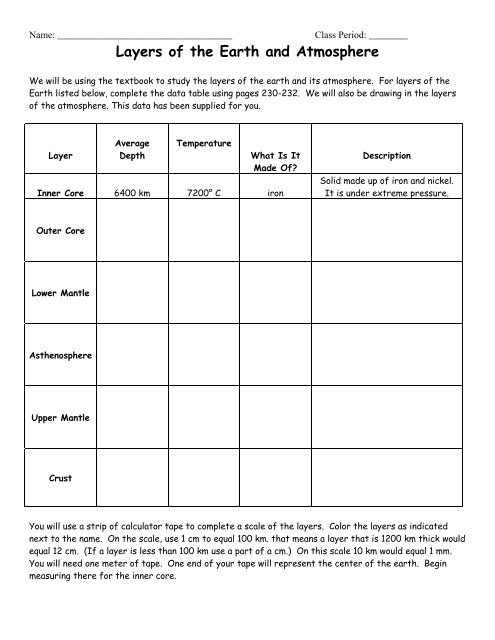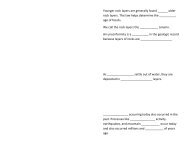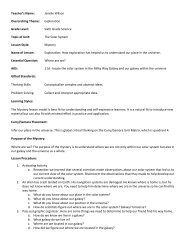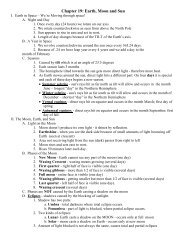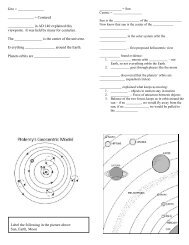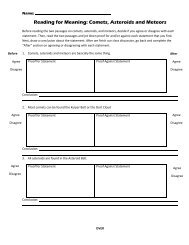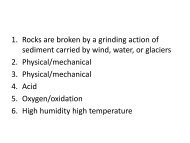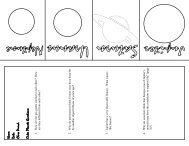Layers of the Earth and Atmosphere - Earth Science with Mrs. Wilson
Layers of the Earth and Atmosphere - Earth Science with Mrs. Wilson
Layers of the Earth and Atmosphere - Earth Science with Mrs. Wilson
Create successful ePaper yourself
Turn your PDF publications into a flip-book with our unique Google optimized e-Paper software.
Name: ____________________________________<br />
Class Period: ________<br />
<strong>Layers</strong> <strong>of</strong> <strong>the</strong> <strong>Earth</strong> <strong>and</strong> <strong>Atmosphere</strong><br />
We will be using <strong>the</strong> textbook to study <strong>the</strong> layers <strong>of</strong> <strong>the</strong> earth <strong>and</strong> its atmosphere. For layers <strong>of</strong> <strong>the</strong><br />
<strong>Earth</strong> listed below, complete <strong>the</strong> data table using pages 230-232. We will also be drawing in <strong>the</strong> layers<br />
<strong>of</strong> <strong>the</strong> atmosphere. This data has been supplied for you.<br />
Layer<br />
Average<br />
Depth<br />
Temperature<br />
What Is It<br />
Made Of<br />
Inner Core 6400 km 7200° C iron<br />
Description<br />
Solid made up <strong>of</strong> iron <strong>and</strong> nickel.<br />
It is under extreme pressure.<br />
Outer Core<br />
Lower Mantle<br />
As<strong>the</strong>nosphere<br />
Upper Mantle<br />
Crust<br />
You will use a strip <strong>of</strong> calculator tape to complete a scale <strong>of</strong> <strong>the</strong> layers. Color <strong>the</strong> layers as indicated<br />
next to <strong>the</strong> name. On <strong>the</strong> scale, use 1 cm to equal 100 km. that means a layer that is 1200 km thick would<br />
equal 12 cm. (If a layer is less than 100 km use a part <strong>of</strong> a cm.) On this scale 10 km would equal 1 mm.<br />
You will need one meter <strong>of</strong> tape. One end <strong>of</strong> your tape will represent <strong>the</strong> center <strong>of</strong> <strong>the</strong> earth. Begin<br />
measuring <strong>the</strong>re for <strong>the</strong> inner core.
<strong>Earth</strong> <strong>and</strong><br />
atmosphere layers<br />
Actual depth<br />
(km)<br />
Model depth<br />
(cm <strong>and</strong> mm)<br />
Inner core 1300 km 13 cm<br />
Outer Core 2200 km 22 cm<br />
Lower Mantle 2240 km 22.4 cm<br />
As<strong>the</strong>nosphere 250 km 2.5 cm<br />
Upper Mantle 395 km 3.95 cm<br />
Crust 15 km 1.5 mm<br />
Troposphere 12 km 1.2 mm<br />
Stratosphere 38 km 3.8 mm<br />
Mesosphere 30 km 3.0 mm<br />
Ionosphere 470 km 4.7 cm<br />
Exosphere No specific depth Use 12.0 cm<br />
Use <strong>the</strong> following colors for your model:<br />
Inner Core – Dark Brown<br />
Outer Core – Orange<br />
Lower Mantle – Red Orange<br />
As<strong>the</strong>nosphere - Red<br />
Upper Mantle – Light Brown<br />
Crust (Continental <strong>and</strong> Oceanic) – Green<br />
Troposphere – Yellow<br />
Stratosphere –Purple<br />
Mesosphere – Light Blue<br />
Ionosphere– Blue<br />
Exosphere – Scattered Blue Dots<br />
When you finish your model, answer <strong>the</strong> following questions on notebook paper using complete sentences.<br />
Staple your notebook paper to this sheet <strong>and</strong> turn in when you are finished.<br />
1. What is <strong>the</strong> thickest layer <strong>of</strong> <strong>the</strong> earth<br />
2. What is <strong>the</strong> thinnest layer <strong>of</strong> <strong>the</strong> earth<br />
3. If you were to use an apple to represent <strong>the</strong> earth, what part <strong>of</strong> <strong>the</strong> apple would represent <strong>the</strong><br />
earth’s crust<br />
4. How have scientists learned about <strong>the</strong> earth’s interior<br />
5. What layers make up <strong>the</strong> lithosphere<br />
6. What is <strong>the</strong> as<strong>the</strong>nosphere <strong>and</strong> why is it important<br />
7. Why is <strong>the</strong> inner core solid even though it is very hot<br />
8. What causes <strong>the</strong> <strong>Earth</strong>’s magnetic field
<strong>Layers</strong> <strong>of</strong> <strong>the</strong> <strong>Earth</strong> <strong>and</strong> <strong>Atmosphere</strong><br />
We will be using <strong>the</strong> textbook to study <strong>the</strong> layers <strong>of</strong> <strong>the</strong> earth <strong>and</strong> its atmosphere. For layers <strong>of</strong> <strong>the</strong><br />
<strong>Earth</strong> listed below, complete <strong>the</strong> data table using pages 230-232. We will also be drawing in <strong>the</strong> layers<br />
<strong>of</strong> <strong>the</strong> atmosphere. This data has been supplied for you.<br />
Layer<br />
Average<br />
Depth<br />
Temperature<br />
What Is It<br />
Made Of<br />
Description<br />
Inner Core 6400 km 7200° C iron<br />
Solid made up <strong>of</strong> iron <strong>and</strong> nickel.<br />
It is under extreme pressure.<br />
Outer Core<br />
5100 km 4300° C Iron <strong>and</strong> nickel Liquid iron; as it moves it creates<br />
electric currents making <strong>Earth</strong>’s<br />
magnetic field.<br />
2900 km 3700° C<br />
Rock<br />
Largest part <strong>of</strong> <strong>Earth</strong>’s interior;<br />
very hot <strong>and</strong> flows slowly<br />
Lower Mantle<br />
As<strong>the</strong>nosphere<br />
660 km<br />
Between Lower<br />
<strong>and</strong> Upper<br />
Mantle<br />
Hot rock<br />
More fluid than o<strong>the</strong>r parts <strong>of</strong><br />
<strong>the</strong> mantle – like jelly; s<strong>of</strong>t<br />
410 km<br />
Lower part <strong>of</strong> <strong>the</strong> lithosphere<br />
870° C Rock<br />
Upper Mantle<br />
Crust<br />
15 km 0° C Granite <strong>and</strong><br />
Basalt<br />
Uppermost layer; cool so it cracks<br />
<strong>and</strong> breaks easily; floats on <strong>the</strong><br />
mantle<br />
You will use a strip <strong>of</strong> calculator tape to complete a scale <strong>of</strong> <strong>the</strong> layers. Color <strong>the</strong> layers as indicated<br />
next to <strong>the</strong> name. On <strong>the</strong> scale, use 1 cm to equal 100 km. that means a layer that is 1200 km thick would<br />
equal 12 cm. (If a layer is less than 100 km use a part <strong>of</strong> a cm.) On this scale 10 km would equal 1 mm.<br />
You will need one meter <strong>of</strong> tape. One end <strong>of</strong> your tape will represent <strong>the</strong> center <strong>of</strong> <strong>the</strong> earth. Begin<br />
measuring <strong>the</strong>re for <strong>the</strong> inner core.
<strong>Earth</strong> <strong>and</strong><br />
atmosphere layers<br />
Actual depth<br />
(km)<br />
Model depth<br />
(cm <strong>and</strong> mm)<br />
Inner core 1300 km 13 cm<br />
Outer Core 2200 km 22 cm<br />
Lower Mantle 2240 km 22.4 cm<br />
As<strong>the</strong>nosphere 250 km 2.5 cm<br />
Upper Mantle 395 km 3.95 cm<br />
Crust 15 km 1.5 mm<br />
Troposphere 12 km 1.2 mm<br />
Stratosphere 38 km 3.8 mm<br />
Mesosphere 30 km 3.0 mm<br />
Ionosphere 470 km 4.7 cm<br />
Exosphere No specific depth Use 12.0 cm<br />
Use <strong>the</strong> following colors for your model:<br />
Inner Core – Dark Brown<br />
Outer Core – Orange<br />
Lower Mantle – Red Orange<br />
As<strong>the</strong>nosphere - Red<br />
Upper Mantle – Light Brown<br />
Crust (Continental <strong>and</strong> Oceanic) – Green<br />
Troposphere – Yellow<br />
Stratosphere –Purple<br />
Mesosphere – Light Blue<br />
Ionosphere– Blue<br />
Exosphere – Scattered Blue Dots<br />
When you finish your model, answer <strong>the</strong> following questions on notebook paper using complete sentences.<br />
Staple your notebook paper to this sheet <strong>and</strong> turn in when you are finished.<br />
1. What is <strong>the</strong> thickest layer <strong>of</strong> <strong>the</strong> earth<br />
2. What is <strong>the</strong> thinnest layer <strong>of</strong> <strong>the</strong> earth<br />
3. If you were to use an apple to represent <strong>the</strong> earth, what part <strong>of</strong> <strong>the</strong> apple would represent <strong>the</strong><br />
earth’s crust<br />
4. How have scientists learned about <strong>the</strong> earth’s interior<br />
5. What layers make up <strong>the</strong> lithosphere<br />
6. What is <strong>the</strong> as<strong>the</strong>nosphere <strong>and</strong> why is it important<br />
7. Why is <strong>the</strong> inner core solid even though it is very hot<br />
8. What causes <strong>the</strong> <strong>Earth</strong>’s magnetic field


